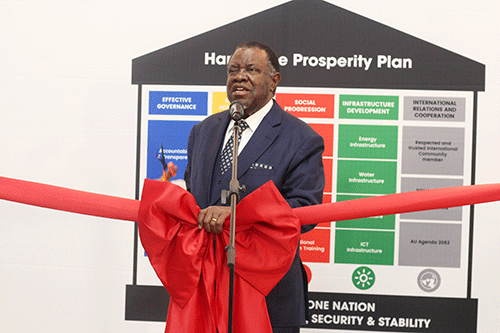President Hage Geingob yesterday officially launched requests for proposals (RFP) for the development of green hydrogen and green ammonia (GH&A) projects in the //Kharas region.
GH&A is being peddled as one of the key fuel sources for a global future to facilitate a carbon neutral world. Preliminary estimates are that Namibia has the potential for annual production of green ammonia in excess of 2.5 million metric tonnes.
This figure is expected to attract more than US$6 billion in foreign direct investment (FDI) which is anticipated to generate annual revenues in excess of US$800 million.
"Namibia is ready to do business and through this, we have a chance to help chart a course for a future,” said Geingob while inviting investors from around the world to converge on //Kharas where the GH&A project is being touted.
The Geingob administration’s second Harambee Prosperity Plan (HPP II) acknowledges the need to develop complementary engines of economic growth as well as the green and blue economies such as green hydrogen as key avenues to attract much needed foreign and local direct investment. In this regard, Geingob said, “We shall not rest until we reach the promise and potential of HPP II.”
Also speaking at yesterday’s occasion, director general of the National Planning Commission (NPC) and chairperson of the recently formed Green Hydrogen Council (GHC), Obeth Kandjoze, noted that Namibia is sufficiently endowed with world-class solar and wind resources in //Kharas.
“When combined with its access to a seaport and vast open land, Namibia is ranked as one of the best countries in the world to produce GH&A,” said Kandjoze.
He added that developed economies are accordingly spending a significant portion of money in research and development to increase the economic viability of hydrogen produced using renewable energy.
“Namibia is thus strategically positioned to benefit from a significant inflow of FDI and has a great opportunity to foster the establishment of a new industry,” Kandjoze stated.
The NPC DG continued that the Green Hydrogen Council has met several times since its establishment while the Green Hydrogen Technical Committee meets more frequently.
“Your excellency, the Green Hydrogen Council assures you that it shall not rest nor leave any stone unturned in its pursuit to deliver the potential of this transformative industry and the Southern Corridor Development Initiative vision as captured in Goal 3 of the Economic Advancement Pillar of the HPP II to the Namibian people,” Kandjoze concluded.
Meanwhile, special advisor to the President on economic matters, James Mnyupe told yesterday’s gathering at State House that the RFP is the culmination of a “Herculean effort” from a variety of government entities that signified a “quintessential example” of collective effort.
Said Mnyupe: “Green hydrogen is not about availing more than 1 600 km2 of pristine land in the Sperrgebiet to facilitate the production of synthetic molecules from Namibia’s abundant renewable energy potential. It is not about facilitating the completion of a feasibility study to unlock more than 5GW of potential wind energy, that would aid with combating climate change and the reduction of emissions as we aspire to limit the escalation of temperatures around the world. It is not even about capitalising on a once in a generation opportunity to tap into a growing sustainability finance market that raised more than US$800 billion in the first six months of this year, surpassing 100% of what was raised in 2020, offering some of the lowest cost of capital in recent history. No, the concept of green hydrogen is about the art of what is possible.”
Furthermore, Germany’s Green Hydrogen Commissioner, Stefan Kauffman, also sent a message to yesterday’s event calling the development of the Green Hydrogen a “win-win for Namibia and Germany”.
Kauffman said this crucial project will make Namibia self-sustainable in terms of energy production with the potential to export green energy to the region and beyond. He also stated the intent to launch a Namibia-German Hydrogen Council within the next few weeks.
Germany’s ministry of education and research is reportedly heavily investing in the green hydrogen industry in Namibia, with the
two governments about to conclude an agreement to invest up to N$680 million (40 million euros).
The GHC is expected to work closely with their German counterparts to plan the deployment of this investment into the crafting of a Namibian Green Hydrogen Strategy, to fund related feasibility studies across Namibia, to partially fund key pilot plants and to help establish a Namibian Green Hydrogen Research Institute, as envisioned by the University of Namibia to conduct critical in-country research and development. The investment will also be used to launch the NamKanda Scholarship Fund which will provide an opportunity for 25 Namibians interested to develop the requisite skills to meaningfully participate in a green hydrogen industry.
Green hydrogen depends on the generation of hydrogen through a chemical process known as electrolysis.
Hydrogen is a universal, light and highly reactive fuel. Electrolysis uses an electrical current to separate the hydrogen from the oxygen in water and if this electricity is obtained from renewable sources, it will produce energy without emitting carbon dioxide into the atmosphere.
The latest estimates by the International Energy Agency (IEA), published at the end of 2019, predict that global energy demand will increase by between 25% and 30% by 2040, which in an economy dependent on coal and oil would mean more CO2, thereby exacerbating climate change.
– ebrandt@nepc.com.na


